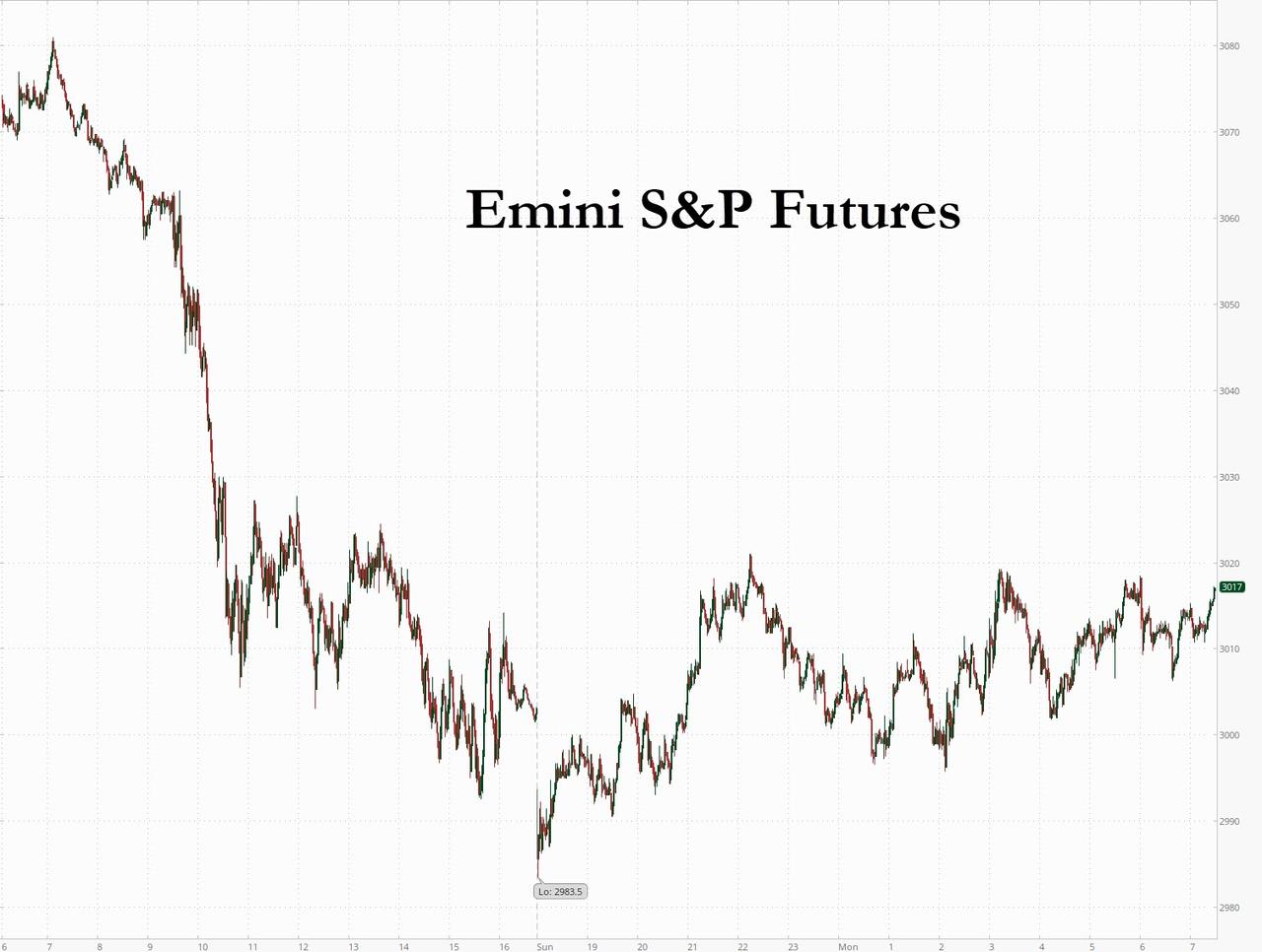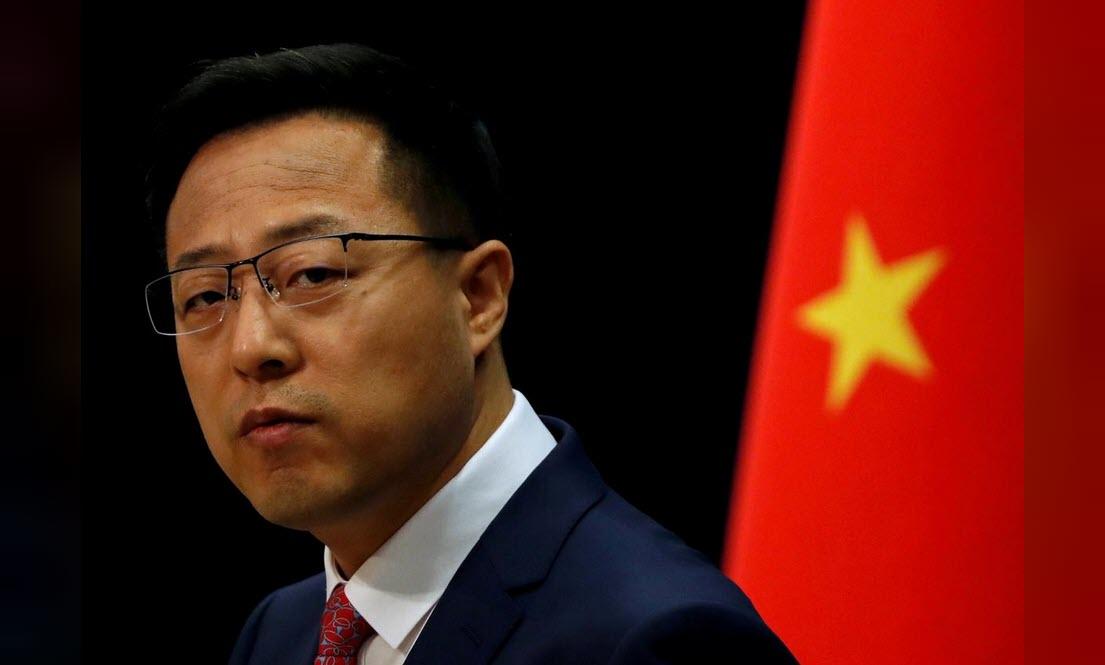Futures Rebound From Early Losses Thanks To Old Faithful Overnight Ramp
Tyler Durden
Mon, 06/29/2020 – 08:01
Yesterday, shortly following the reopen for electronic trading at 6pm, we wrote that futures slumped “in a repeat of last Sunday’s gloomy open” however previewing that this slump “had fully reversed overnight with futures nice and green by morning” and sure enough the magical overnight ramp emerged once again, with Eminis reversing all early losses and trading near session highs at 3,016 at last check, with the dollar turning red and 10Y yield higher on the day even as the yield on 5Y Treasurys hovered near a record low.
One catalyst cited for the overnight strength is a report out of China that a coronavirus vaccine developed by a Chinese firm received approval for military use and a stronger-than-expected yuan fixing weighed on demand for haven assets.
Additionally, as Nomura’s Charlie McElligott writes, “equities start lower and USTs start bull-flatter in Asia…before reversing Europe-into-US session, with global stock futs now marginally better, curves bear-steepening, Crude rallying and again Dollar fading lower, as markets continue to feel very constructive on the Eurozone Coronabond issuance project as Germany capitulates away from austerity and towards both debt mutualization and fiscal stimulus.”
Whatever the driver, after major Wall Street indexes had tumbled more than 2% on Friday as several U.S. states imposed business restrictions in response to the surge in COVID-19 cases, sentiment reversed completely even as stocks in Asia and Europe were generally muted overnight as the global death toll from the respiratory illness crossed half a million on Sunday
In premarket trading, Boeing rose 3.2% after the Federal Aviation Administration confirmed on Sunday it had approved key certification test flights for the grounded 737 MAX that could begin as soon Monday, while Facebook looked set to extend declines from Friday as a report said PepsiCo was set to join a growing number of companies pulling ad dollars from the social media platform.
“The recovery is going to be much slower and much more uneven than most people believe,” David Hunt, president and chief executive officer of PGIM Inc., told Bloomberg TV. “Markets are priced for a much sharper V-shaped recovery, which we don’t think is likely.”
European stocks were firmly in the green after starting off on the back food amid light trading volumes. In Asia, stocks fell more than 1% in Japan, Australia and Hong Kong. Japan’s Topix declined 1.8%, with DLE and Watabe Wedding falling the most. The Shanghai Composite Index retreated 0.6%, with Anhui Xinli Finance and Xiamen C&D posting the biggest slides
As Bloomberg reports, “investors began the week studying conflicting signals, as virus deaths surpassed 500,000 globally and the epicenter moves to the America. With U.K. households amassing savings at a record level and paying down debt in May, Prime Minister Boris Johnson has promised a wave of investment in infrastructure and skills.”
In rates, Treasuries were mixed with the curve fractionally steeper into early U.S. session after paring gains as U.S. stock index futures moved higher. Bunds also bear-steepened, underperforming Treasuries. Session low yields were reached as virus cases continued to mount worldwide. Month- and quarter-end needs are expected eventually to provide support. Yields were cheaper by ~1bp in long-end tenors, steepening 5s30s by ~2bp, 2s10s by ~1bp; 10-year yields around 0.65%, cheaper by less than 1bp on the day while front end and belly are richer by less than 1bp; 5-year yield at ~0.30% is within 3bp of its May 8 record low. Bunds lagged by ~1bp vs Treasuries while gilts outperform by ~1bp.
In FX, the dollar started off strong but then edged lower against most Group-of-10 peers, though moves in the crosses were largely confined to narrow ranges; it earlier weakened after a coronavirus vaccine developed by a Chinese firm received approval for military use and a stronger- than-expected yuan fixing weighed on demand for haven assets. The euro advanced, supported by an acceleration in German state inflation rates; it touched an intraday high as European funds engaged in basket-selling of the dollar and bought the shared currency. The pound gave up an Asia session gain which had followed British Prime Minister Boris Johnson’s promise of a “big plan” to help the U.K. bounce back from the coronavirus pandemic, as he seeks to revive his struggling political mission with a major speech on Tuesday. Australia’s dollar pared gains after earlier rising to an intra-day high amid corporated hedging activities into the end of the month and the nation’s fiscal year.
In commodities, oil kept falling after just its second weekly drop since April as coronavirus infections and fatalities surpassed grim milestones in a reminder the outbreak is far from under control in many parts of the world.
This holiday-shortened week (Friday is a day off, and the jobs report will be published on Thursday), investors will focus on employment, consumer confidence and manufacturing data for June for signs of whether the U.S. economy will continue to rebound after indications of a pickup in May. On today’s calendar we have pending home sales, Dallas Fed manufacturing activity, while the Treasury sells 13-week and 26-week bills. New York Fed President John Williams moderates a discussion with IMF Managing Director Kristalina Georgieva.
Market Snapshot
- S&P 500 futures up 0.2% to 3,014
- STOXX Europe 600 little changed at 358.37
- MXAP down 1.2% to 157.17
- MXAPJ down 0.9% to 509.88
- Nikkei down 2.3% to 21,995.04
- Topix down 1.8% to 1,549.22
- Hang Seng Index down 1% to 24,301.28
- Shanghai Composite down 0.6% to 2,961.52
- Sensex down 1% to 34,837.36
- Australia S&P/ASX 200 down 1.5% to 5,815.03
- Kospi down 1.9% to 2,093.48
- German 10Y yield rose 1.4 bps to -0.468%
- Euro up 0.3% to $1.1248
- Brent Futures down 2.1% to $40.16/bbl
- Italian 10Y yield fell 1.3 bps to 1.164%
- Spanish 10Y yield rose 1.3 bps to 0.471%
- Brent Futures down 1.2% to $40.52/bbl
- Gold spot down 0.13% to $1,769.05
- U.S. Dollar Index down 0.1% to 97.31
Top Overnight News from Bloomberg
- Deaths from the coronavirus worldwide topped 500,000 and infections surged past 10 million, two chilling reminders that the deadliest pandemic of the modern era is stronger than ever
- Fast-money hedge funds are rushing to cover their bearish U.S. stock bets even as the equity rally threatens to break down. Speculative investors bought the most S&P 500 Index E-mini since 2007 in the week to June 23, according to the latest Commodity Futures Trading Commission data. Net short positions in the contracts were at their highest in almost a decade as the U.S. equity rebound pushed the benchmark back toward record territory
- Germany plans to raise 146 billion euros in the third quarter from bond sales and money market instruments, almost triple an earlier estimate, as the nation seeks to help spur an economic recovery from the coronavirus
- China will impose a visa ban on U.S. citizens who interfere with sweeping national security legislation planned for Hong Kong, a move that comes shortly after the Trump administration imposed them on some officials in Beijing
- The world’s biggest bond market is holding firm in its conviction that the revival of the American economy from the devastation of the pandemic will be slow and fragmented
- The Swiss National Bank says the lower limit for the special liquidity-shortage financing facility rate will be reduced to at least 0% from current level of at least 0.5%
Asian bourses began the week lower across the board with sentiment dampened as focus remained on rising virus infection rates which has forced some key states to back-pedal on their reopening efforts with California, Texas and Florida imposing new restrictions, while the global death toll from the pandemic has surpassed the half million mark. ASX 200 (-1.5%) was dragged lower with energy underperforming the broad weakness seen across Australia’s sectors aside from gold miners which stayed resilient on the safe-haven play, and Nikkei 225 (-2.3%) was pressured after weaker than expected Retail Sales data and with the number of new infections in Tokyo rising to the most since the removal of the state of emergency declaration. Hang Seng (-1.0%) and Shanghai Comp. (-0.6%) declined following a liquidity drain by the PBoC and amid concerns regarding the Hong Kong national security law in which the NPC Standing Committee reviewed a draft on the bill and are set for a vote tomorrow. This is likely to increase the ongoing US-China tensions, which was also not helped by comments from both sides as US Secretary of State Pompeo noted the US is imposing visa restrictions on Chinese Communist Party officials over the autonomy of Hong Kong as well as human rights issues, and Chinese officials warned the US of crossing red lines such as meddling in Hong Kong and Taiwan which could put the trade deal’s purchases at risk. Finally, 10yr JGBs were rangebound with price action only marginally benefitting from the broad risk-averse tone and BoJ’s presence in the market for a total of JPY 600bln of JGBs heavily concentrated in 5yr-10yr maturities. PBoC skipped reverse repos for a drain of CNY 40bln but conducted CNY 5bln of commercial bill swaps. (Newswires)
Top Asian News
- Philippine Central Bank Chief Sees No Need for Rate Cut Now
- Indonesia Nears Deal With Central Bank on Deficit Funding
- Young Blood May Fail to Curb Japan’s Support for Coal Power
An eventful start to the week for the equity-space in terms of price action (Euro Stoxx 50 +0.4%) after the region initially picked up the baton from the relatively downbeat APAC handover. Europe opened with broad losses to the tune of around 0.4-0.5% before immediately trimming downside to trade firmly in positive territory. Thereafter gains dissipated with no fresh fundamental factors immediately affecting the bourses, however, repots that the Chinese Foreign Ministry will be putting visa restrictions on US relations over Hong Kong added to the US-Sino woes ahead of the National Security Bill vote tomorrow – expected to swiftly pass through for implementation from July 1st. It’s also worth bearing in mind month/quarter/HY-end flows influencing price actions as firms rebalance portfolios. Nonetheless, a mixed performance is now seen across major European cash bouses, whilst State-side, the E-Mini S&P failed to breach resistance at its 200 DMA ~3019.00 and currently meanders just under the key level. Sectoral performance is also mixed after the regions opened mostly lower, albeit the IT sector holds its position as the outperformer, potentially on the back of AMS (+4.0%) after EU antitrust regulators gave the green light for its takeover of Osram Licht (+0.3%). The Energy sector meanwhile lags amid price action in the oil complex. The detailed breakdown paints a similarly mixed picture with no clear risk tone to be derived; Travel and Leisure (-0.3%) remains closer to the bottom of the pile as investors fear the repercussions in the sector in light of a second resurgence of global COVID-19 cases. In terms of individual movers, Wirecard (+145%) shares traded higher by over 200% at one point – potentially on consolidation from its recent detrimental performance as its scandal deepens, however, sources over the weekend noted that that several investors are considering purchasing parts of Wirecard. Elsewhere, BP’s (+2.6%) gains were exacerbated as its stated that its Petrochemical unit sale to INEOS will further strengthen finances and will deliver USD 15bln divestment targets a year early. Airbus (+2.3%) shares opened lower with losses deeper than 2% as the group said it will cut production by around 40% over two-years. Commerzbank (+2.4%) holds onto opening gains as sources stated the board is looking at an aggressive cost-cutting plan – potentially including around 7,000 layoffs alongside 400 branch closures.
Top European News
- BP Speeds Up Transformation With $5 Billion Chemicals Unit Sale
- Europe Slowly Picks Up Pieces After Virus Shattered Economy
- Inside the Brexit Talks, Frustration Starts to Give Way to Hope
In FX, the DXY is holding between 97.051-141 parameters amidst the ongoing resurgence of COVID-19 in several US states, but with technical support via the 21 DMA at 97.050 keeping the index underpinned above 97.000 as the clock ticks down to the end of June, Q2 and the first half of 2020. Moreover, several Greenback/G10 pairs are also observing chart levels against the backdrop of fragile/fluid risk sentiment on a variety of (mainly geopolitical) factors beyond the coronavirus and uncertainty about 2nd waves as more countries reopen. Back to the Buck, pending home sales and the Dallas Fed manufacturing index may provide some fundamental impetus ahead of Fed rhetoric from Daly and Williams.
- EUR – A marginal outperformer and trying to extend gains above 1.1200 vs the Dollar, but finding resistance around 1.1250, the 200 HMA (1.1241) and 1.1240 pivot tough to convincingly breach before decent option expiry interest at 1.1270 (1 bn) in the run up to preliminary German CPI data. However, the single currency has cleared a psychological, if not really significant from a technical standpoint, marker against Sterling as Eur/Gbp crosses 0.9100 for the first time in some 3 months awaiting the start of intensive Brexit trade talks.
- NZD/CHF/CAD/AUD – All marginally firmer vs the Usd, but rangy with the Kiwi hovering above 0.6400 and Franc over 0.9500, though the latter lagging Euro either side of 1.0650 following latest weekly Swiss sight bank deposits showing a rebound in both domestic and total balances. Elsewhere, the Loonie is holding within a 1.3697-46 band ahead of Canadian building permits and ppi even though crude prices remain soft and the Aussie is straddling 0.6865-70 despite a record rise in Victorian virus cases.
- JPY/GBP/SEK/NOK – The Yen is sitting just under 107.00 and right in the middle of 10/50 DMAs at the round number and 107.37 respectively after sub-forecast Japanese retail sales overnight, while Cable is drifting back down from circa 1.2390 towards sub-1.2315 stops after weaker than expected UK consumer credit mortgage approvals, but perhaps more jittery about the aforementioned next phase of negotiations with the EU. Nevertheless, offers are said to be in place around 1.2410 and close to the 50 DMA (1.2412-15), while nearest upside targets in Eur/Gbp are at 0.9139 and 0.9144 (March 23 and 24 peaks respectively). Similarly, the Swedish Crown is underperforming in wake of a much narrower trade surplus. Indeed, Eur/Sek is back up near 10.5000, while Eur/Nok pivoting 10.9000 irrespective of the downturn in oil noted above.
- EM – Broad declines vs the Dollar, and especially the crude/commodity bloc, such as the Rouble and Mexican Peso, but the Turkish Lira deriving some comfort from an improvement in economic confidence with Usd/Try rotating around 6.8500.
In commodities, WTI and Brent front-month futures trade choppy within a tight range, albeit remain in negative territory after the complex kicked off the trading week on the backfoot amid rising global COVID-19 infections hampering reopening efforts in key US states, whilst some eastern Asian countries extended their alerts level and China’s Hebei province put around half a million residents under a Wuhan-style lockdown. Aside from virus woes, news-flow has been quiet from a fundamental standpoint. Participants will want to keep an eye on how the Hong Kong National Security Bill pans out for wide US-China relations as the sides slap tit-for-tat visa restrictions over the city. WTI August hovers just above USD 38/bbl having found support at USD 37.50/bbl while its Brent counterpart sees itself north of USD 40.50/bbl after touted support touted last week around the USD 40.05/bbl region. Elsewhere, spot gold trades with modest losses sub-1770/oz; albeit more a function of month-end rebalancing as opposed to risk-tone or Dollar dynamics. Copper prices meanwhile climbed over a five-month peak in Shanghai amid a softer Buck and supply risks from its top producer Chile.
US Event Calendar
- 10am: Pending Home Sales MoM, est. 18.0%, prior -21.8%; YoY, est. -22.0%, prior -34.6%
- 10:30am: Dallas Fed Manf. Activity, est. -22, prior -49.2
DB’s Jim Reid concludes the overnight wrap
This is the first time I’ve written any piece of work – well since I was doing my GCSEs at school – where I do so in an environment where Liverpool are English Premier League champions. It feels good. I had the day off from the EMR on Friday which was handy as I stayed up late watching the celebrations on telly Thursday night. Let’s hope it’s not the only year of my career where this is the case!! The only bad news from Thursday was that I had bad back spasms playing in the Worplesdon Pro-Am Charity golf tournament and hobbled off the course at the end only just breaking 90!! I play off 6 for context. I’ve completely remodelled my swing over the last 15 months. It now looks beautiful but struggles to connect with the ball properly or send it in a straight line. I’m not sure how much longer I’ll give it before I go back to ugly but effective!
The headline covid case numbers also don’t look too pretty at the moment as we passed 10 million reported cases globally over the weekend and 500k fatalities. Obviously this is only a proportion of the actual case load so it’s difficult to derive too much info from the figure other than the fact that the numbers have been increasing of late, partly due to the wider reported spread of the virus in the Americas and in the likes of India. However the accelerating case numbers also reflects increased testing as well. Fatalities aren’t rising to anything like the same degree as they did in March and April but it’s not easy to work out how much of that is due to more testing diluting the case fatality rate, how much it’s due to better treatment of the virus, and how much is due to a lower risk demographic contracting the virus. As an anecdote, on Friday it was reported via a University of Oxford study that in England, the hospital fatality rate from covid has dropped from 6% at the peak to around 1.5% in June and still declining. It seems we are better at treating the virus now which is good news and it’s also likely that the more vulnerable are being better shielded.
So if this continues it should be seen as a positive. However for now while the virus spread increases in the US there is going to be a lot of concern and confusion about the strategy and the end outcome, especially in the hotspot states and whether it spreads back into the states where the virus has been suppressed.
The latest over the weekend points to things getting worse in case numbers in southern US. The weekly average of covid-19 cases in the US has now surpassed the heights of the spring, while the US recorded an all-time high in new cases on Saturday with over 45,400. Texas, Florida and Arizona have either paused or rolled back reopening plans in light of the new cases, however they are not enacting stricter measures that were seen earlier in the pandemic in places like New York. Over the weekend, Florida Governor DeSantis cited people in the 18-to-44 age group as the cause of the recent rise in positive Covid-19 tests. The Governor said, “Most of this is not because of people going to work, it’s because they’re being social”. This does not sound like someone who wants to shut businesses down again.
While Texas, Florida and Arizona remain among the most worrying in terms of new cases, other southern US states have either slowed down reopening plans or indicated intentions to do so. The positive test rate for Texas has now soared to a record 14.3%. Arkansas, just northeast of Texas, announced they will pause their phased reopening until the current wave subsides, while other neighboring states have indicated similar intentions if case counts continue to rise. In terms of the effective transmission rates (Rt), 33 US states now have Rt values over 1.0. In fact only 2 states, Connecticut and Massachusetts, have their entire confidence level under 1.0 at this point, compared to 7 over 1.0. Fatality rates have yet to see spikes similar to that of cases, and as we have discussed this is hopefully a result of protecting the higher risk and improving treatment. Though for the medium term it seems like US economies are set to reinstitute pauses if the case count continues to get out of hand. So even though the virus seems to be becoming less deadly, confidence has been shaken so much that countries will struggle economically while case levels remain high. In the pdf today (“view report”) we show the usual global case and fatality tables and also repeat the 7 day lagged charts of case and fatalities in the US and the four big hot spot states. We also show what happened with NY for a comparison. There are some signs that deaths in Arizona are responding higher to some degree to lagged case growth but for now the other states are seeing the relationship weaken which is good news. It’s the same for the US overall, especially relative to the first wave.
In terms of markets, bourses in Asia are on the back foot this morning following the heavy losses on Wall Street on Friday with the Nikkei (-2.02%), Hang Seng (-1.59%), Shanghai Comp (-0.71%), Kospi (-1.53%) and ASX (-1.75%) all down. Meanwhile, futures on the S&P 500 are down a much more modest -0.10% and yields on 10y USTs are flat. Elsewhere, WTI crude oil prices are down -1.87% to $37.77.
Here in the UK, Prime Minister Boris Johnson said in an interview in the Mail yesterday that the UK will spend large sums on hospitals, schools and roads to jump-start the economy while rejecting a return to the austerity policies that followed the 2008 financial crisis. PM Johnson is expected to unveil the spending plans in a major speech on Tuesday. In other overnight news, Bloomberg has reported that China’s imports of US goods through May reached c. 19% of the total target for 2020 set in the phase 1 trade deal. China purchased 22.1% of targeted manufactured products, 20.8% of targeted agricultural products and 3.1% of targeted energy products. Meanwhile, French central bank head Francois Villeroy de Galhau played down the prospect that the ECB would buy high yield bonds as part of its pandemic emergency program saying “the debate is probably not urgent,” while further adding “I rule out that we buy bonds that were rated ‘junk’ before the crisis.” However, he also said that the ECB must examine whether it can reduce the dependence of its monetary policy on rating companies.
As for this week, we’ll see a shortened trading period with Friday a US holiday in lieu of Independence Day on Saturday. Thursday will likely see activity wind down early and rapidly ahead of the weekend. The last major act of the week will therefore likely to be the all-important payrolls report brought forward to Thursday. Our US economists are looking for a further +2m gain in non-farm payrolls, following last month’s unexpected +2.509m increase, along with a further reduction in the unemployment rate to 12.6%. This improved labour market performance chimes with what we’ve seen in other indicators, such as the weekly initial jobless claims that have fallen for 12 consecutive weeks now. That said, it’s worth remembering that given the US shed over 22m jobs in March and April, even another +2m reading would still mean that payrolls have recovered less than a quarter of their total losses, suggesting there’s still a long way to go before the labour market returns to normality again.
The other main data highlight will be the final June PMI releases from around the world. The manufacturing numbers are out on Wednesday before the services and composite PMIs come out on Friday for the most part (ex US), while there’ll also be the ISM manufacturing index too from the US (on Wednesday). For the countries where we already have a flash PMI reading, they generally surprised to the upside, even as many remained below the 50-mark. It’ll also be worth keeping an eye on the numbers for China, given they’re some way ahead in the reopening process relative to the US and Europe.
In politics, a key highlight this week will be a meeting between Chancellor Merkel and President Macron taking place today, where both the EU budget and the recovery fund will be on the agenda. That comes ahead of another summit of EU leaders scheduled for the 17-18th July, where the 27 leaders will meet in person in Brussels for further discussions on the recovery fund. Meanwhile, the start of July on Wednesday formally sees Germany take over the rotating EU presidency, which they’ll hold for the next six months.
Staying with politics, Brexit negotiations between the UK and the EU on their future relationship will return once again. This will be the first set of intensified talks that are taking place every week over the next five weeks, as the two sides look to come to an agreement following fairly slow progress in the talks thus far. Since the last round of negotiations, a high-level meeting took place between Prime Minister Johnson and the Presidents of the European Commission, Council and Parliament, where the two sides agreed in their statement that “new momentum was required” in the discussions. There does seem a bit more positivity now than there was a month ago but much work still needs to be done.
Elsewhere we have the release of the FOMC minutes for the June meeting on Wednesday, along with an appearance by Fed Chair Powell and Treasury Secretary Mnuchin tomorrow before the House Financial Services Committee. Otherwise, speakers next week include the BoE’s Governor Bailey and Deputy Governor Cunliffe, along with the ECB’s Schnabel and New York Fed President Williams.
Recapping last week now. Global equities fell on the week with the S&P 500 falling -2.86% (-2.42% Friday) and is now down -1.16% for the month of June with two days of trading left in the month. This could be the first monthly loss since March. The tech-focused NASDAQ underperformed slightly last week, down -3.31% (-2.84% Friday) but is +2.82% in June so far. European equities outperformed the S&P as case growth remains relatively contained versus in the US, with the Stoxx 600 falling a lesser -1.95% (-0.39% Friday) over the five days. The pullback was well correlated as the DAX (-1.96%), FTSE MIB (-2.52%), and FTSE 100 (-2.12%) indices all fell to similar degrees on the week. Asian indices were more mixed. The Nikkei rose +0.15% over the week (+1.13% Friday) and the CSI 300 was up +0.98% on a 3 day week, while the Kospi fell -0.31% (+1.05% Friday).
With concerns over the implications for global growth if the recent virus spread continues, oil prices fell on the week. Brent crude futures fell -2.77% (-0.07% Friday) to $41.02/barrel and WTI crude retreated -3.17% on the week (-0.59% Friday) to $38.49/barrel. In other commodities, gold rallied +1.57% (+0.43% Friday) to levels last seen in October 2012.
Gold was not the only haven to rally with risk assets weakening. Core sovereign bonds gained on the week with US 10yr Treasury yields falling -5.2bps (-4.4bps Friday) to finish at 0.641%, while 10yr Bund yields fell -6.7bps over the course of the week (-1.4bps Friday) to -0.48%. UK gilts fell -6.6bps (+1.8bps Friday) to 0.17%. As risk sentiment turned, peripheral debt widened slightly on the week. Spanish 10yr yields widened +3.2bps to German bunds over the 5 days, while Portuguese bonds widened +1.6bps and Greece bonds widened +5.3bps. Credit spreads widened considerably more, particularly in the US. US HY cash credit spreads were +39bps wider on the week (+11bps Friday), while IG widened +5bps (+1bp). European HY cash spreads were + 17bps wider (unchanged Friday) with IG just +5bps wider (unchanged Friday).
On the data front, US consumer spending rose +8.2% (vs. +9.3% exp.) from the prior month on Friday. This was the highest monthly increase in over 60 years of data keeping, but the overall level still remains far below pre-pandemic levels. This follows spending falling the most on record in April. Incomes declined -4.2% (vs. -6.0% exp.), just below the record decrease, after last month’s ‘largest-ever’ increase that was primarily driven by household relief payments. The University of Michigan Sentiment survey rose from 72.3 to 78.1 (vs. 79.2 exp.), but remains near 7 year lows. The sentiment data was similar in Europe where French consumer confidence rose to 97 from 93 (vs. 95 exp.), while Italian consumer confidence rose 7.3pts to 100.6 (vs. 97.5 exp.). So while sentiment is improving off the lows in April and May, there is still a lot of recovery left. Lastly, Euro Area M3 money supply growth for May was +8.9% (vs. +8.7% exp.).
via ZeroHedge News https://ift.tt/3g6n2AK Tyler Durden





